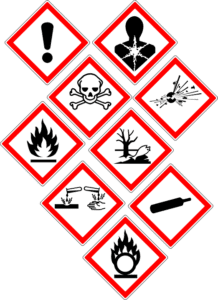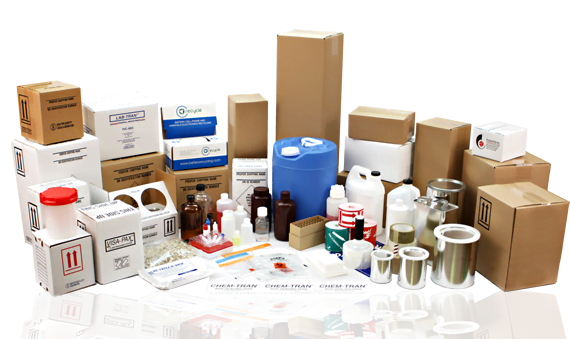Safety should always be a prime consideration when it comes to the task of shipping hazardous materials in the safest way possible and any flaws in your safety protocols could lead to a dangerous scenario that could have been avoided with good practices and safety guidelines being observed.
If you are not sure what those protocols are for packaging hazardous materials, here are some essential safety guidelines to review and implement.
5 Essential Guidelines for Shipping Hazardous Materials to Always Keep in Mind:
1. Defining what is hazardous:

To be able to satisfactorily deal with the task of transporting hazardous materials to another destination, whether that is across state lines or to an international location, the first thing to do is to clearly define exactly what constitutes hazardous materials.
As you might expect, there are clear government guidelines that help to define and classify hazardous items. Dangerous and hazardous items can come in various forms, typically they are going to be either, gases, liquids, or solids.
Beyond that basic description, you also have to be aware of each item’s hazardous effects and it is also relevant to be mindful that the material might be transparent, or odorless, for example, and they could be a purely chemical composition or a mixture of different substances.
You will find that hazardous items are normally classified according to the nature of the hazard they represent, such as being flammable, or poisonous, for instance.
Your first task should always be to classify the hazardous items you want to ship so that you can then seek to find the correct and safest way to transport them.
2. Regulations are there for a reason:
It should come as no surprise that the transportation of hazardous materials is highly regulated across the globe and there are clear regulations in place that apply to not just the materials that you are shipping but the mode of transport is used to carry those items.
Although there are some safety standards that could be classed as fairly universal wherever in the world you happen to be it should be noted that various restrictions and regulations can vary between countries.
This is highly relevant if you intend to ship hazardous materials across different countries because you might discover that you need to have additional safety measures in place in order for the journey to be completed successfully.
If you are shipping anything hazardous by sea, for instance, you will find that that the International Maritime Dangerous Goods Code (IMDG Code) is utilized as the internationally recognized and accepted regulation in use.
As you should expect, the code is regarded as mandatory and enforced to ensure that anyone coming into contact or within close proximity of the items is suitably protected.
3. Shipping by road:
Shipping hazardous materials by road are also highly regulated but there is a fundamental difference to appreciate when compared to shipping by sea.
The IMDG Code is the internationally recognized safety standard for shipping by sea but you will discover that each country has created its own set of safety regulations when it comes to transporting items by road.
For instance, the United States has the Code of Federal Regulations 49, which encompasses the transportation of hazardous materials from inside the country and for when shippers arrive from overseas.
You will need to familiarize yourself with the various regulations relevant to the destination in question so that you are fully compliant and ensure that safety standards are met at all times.
4. Make sure your packaging procedures are suitably robust and compliant:
In addition to making every effort to ensure compliance with regard to the regulations, you will also have to focus a lot of your attention on getting your packaging protocols and procedures right.
Labeling is a key area where mistakes can often be made.
If you are using packing containers such as cartons or drums, it is absolutely essential that you pay attention to your use of labeling and take steps to make sure that only the relevant safety warnings and critical contents data is displayed.
It might sometimes be required to provide handling guidance with suitable warnings if the contents can become dangerous when exposed to heat or the effects of condensation.
In general terms, the packaging label needs to identify the appropriate risk category according to the IMDG Code, if it is being shipped by sea, and it would be prudent to provide emergency contact information on the label so that guidance can be sought if there is a potential problem during the transportation process.
5. Accurate documentation is critical to completing the journey:
There are numerous challenges and administrative hoops that you will have to jump through if you are going to be successful in your quest to ship some hazardous materials from A to B.
Probably one of the most critical aspects of shipping hazardous materials is the need to use the correct documentation.
Any discrepancy or piece of information missing could quickly halt the progress of your shipment and it is perfectly understandable that when the cargo is something that is classed as hazardous, no one should be expected to take any chances.
As already outlined, your first task should be to correctly identify the classification of the hazardous goods you are shipping and then take the time to confirm exactly what paperwork you will need in order to comply with all the relevant safety and customs regulations.
When you consider that each type of hazardous material presents its own unique challenges in terms of how it is handled and what the actual nature of the hazard is, it is clear that the safest way to make everyone aware of what they are dealing with is through the diligent use of correct documentation.
If there is any weak link in the shipment chain it could create a dangerous scenario and that is why that everyone needs to be trained and aware of each process that needs to be followed when shipping hazardous materials.
If you take a proactive approach to safety training and awareness of all relevant regulations it should help to provide a safer passage for all of your shipments that are classed as hazardous.
Read Also:




























